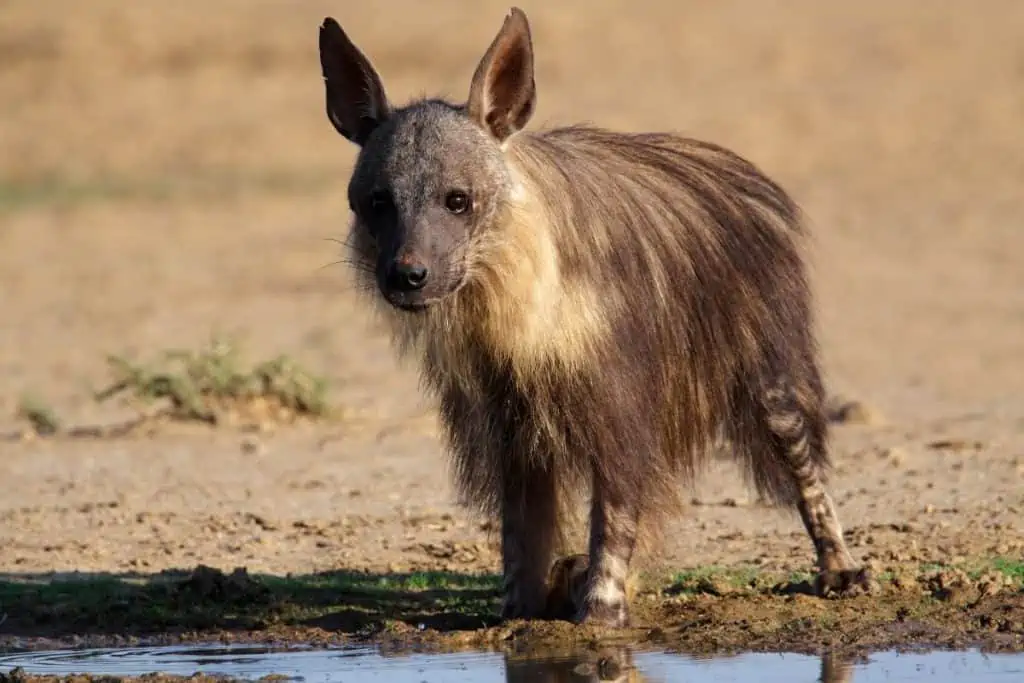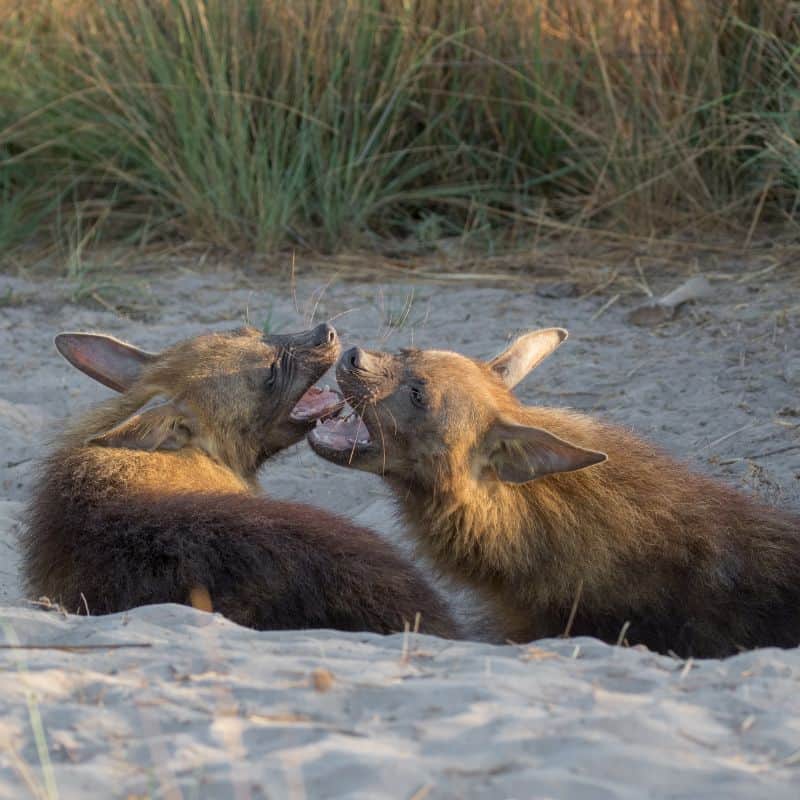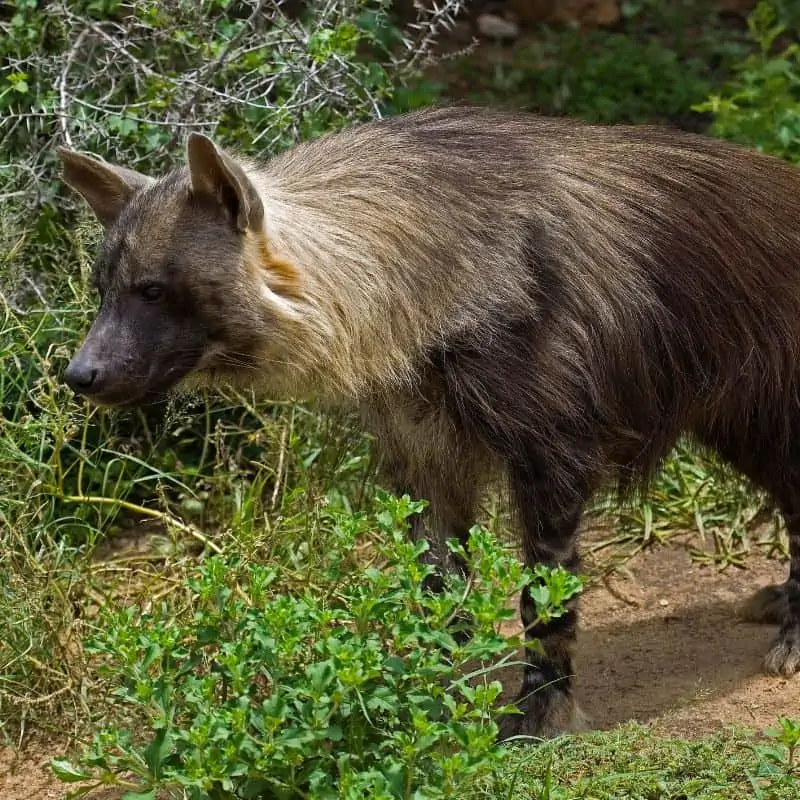The pointy ears and oversized shaggy coat distinguish a brown hyena from other species of hyena. Brown hyenas are very aggressive, and without knowing much about this species, it can be difficult to tell them apart from other hyenas.
The Kalahari desert’s harsh landscape is where brown hyenas are most frequently seen. Due to their nocturnal nature, adult brown hyenas spend the day sleeping in the shade of bushes or trees to avoid getting overheated. Adult brown hyenas go hunting alone, using scent-marked pathways they’ve previously used.
In this article, we will look at the various characteristics and traits that set Brown Hyenas apart.

10 Facts About Brown Hyenas
Here are ten facts about Brown hyenas that differentiates them from their spotted and striped cousins (and aardwolves, which are also members of the hyena family).
1. Brown Hyenas are Scavengers
Unlike spotted hyenas, this cunning animal is a scavenger of meat, not a hunter.
The brown hyena’s primary food source is dead animal carcasses. However, it occasionally consumes live prey like birds and small mammals.
Despite being predominantly carnivores, brown hyenas occasionally have to eat ostrich eggs and desert melons.
Scavengers can’t be choosers.

2. Communication
These hyenas have an acute sense of smell. The scent markers are crucial for identifying areas and allowing clan members to exchange vital information without physical contact.
These odors aid hyenas in determining territorial borders and whether a specific area has already been investigated for food.
The cubs are called into the den with a soft call, and sometimes rivals will meet after a harsh roar.
3. Size And Speed
There are no significant variations between the sexes; unlike the giant spotted hyena, males may be slightly larger than females.
Male adults typically weigh 40.2-43.7 kg, while female adults often only weigh 37.7-40.2 kg.
Brown hyenas are surprisingly fast and can reach speeds of 50 kph (31 mph), but not quite as fast as a Spotted hyena (60 kph / 37 mph).
4. Smaller Clan Size
Unlike the spotted hyenas, which might have a clan of up to 90 members at a time, the clan size of the brown hyenas is relatively small.
Even though they are typically seen foraging alone, brown hyenas are still communal to an extent.
They are social beings who live in clans, whose members have incredibly complex interactions with one another.
A single adult female and her kids or up to 14 members can make up a clan.

5. Marking Territory With Secretion
Adult brown hyenas “pass” secretions from their anal gland onto grass stalks to identify their territory. Brown hyenas also use this method of secretion to interact.
Each hyena’s secretion is distinct. Therefore, the white blob left behind reveals essential details about each one, including its identification and the time since it last passed by.
In this way, every hyena in a region is aware of what the others are doing.
6. Habitat
These hyenas may live in various settings and are adaptive and widespread.
They frequently live in the Kalahari and Namib desert dry zones. However, they live on the edges of residential areas, grasslands, and coastlines.
Brown hyena sightings are frequent in wooded and rocky highland regions.
Being extraordinarily adaptable and clever, they can live in almost any habitat. One of these evasive hyenas has even been seen near Pretoria, the capital of South Africa.
7. Fierce Behaviour
Brown hyenas are fierce and may readily compete with lions and leopards for prey.
They share habitat and food sources with big cats, and the two species have vicious and protracted competition.
The fight’s victor gets fed, and these hyenas make for exciting foes. They adopt a battle stance that includes raising their long manes and neck fluff to project a more prominent and threatening appearance.
These physical characteristics are harmed in a battle, and it’s not unusual to see a hyena’s scruff torn and battered.
8. Night Owl
Brown hyenas are substantially quieter than other hyenas.
Being nocturnal creatures, they are most active at night, and during this time, they communicate through various sounds.
There are growls, grunts, and a sinister cackle among these noises, but they don’t laugh.
9. Jaw Strength
It’s not simple for animals to consume carcasses, and most creatures can’t do it. Brown hyenas are natural scavengers, and they make good use of their powerful jaws.
Compared to their relatives, brown hyenas have powerful jaws and broader skulls.
They can crush even the most rigid bones. A pack of hyenas may easily consume an entire zebra and other large mammals.
10. Intelligence
Due to their unattractive look and reputation for stupidity, brown hyenas lose favor with the public. This is an unjustified conclusion.
In actuality, brown hyenas are among the most socially advanced mammals in the world and intelligent creatures.
They have a larger frontal cortex and are more socially and cognitively developed than chimpanzees, studies have shown.

Final Thoughts On Brown Hyenas
These shaggy-looking creatures have layers of intricacies hidden in them.
Brown hyenas are fascinating species that have captivated the minds of scientists and other observers.
The depictions of hyenas in the popular media create a false image of these intelligent animals.
FAQs
Is the Brown Hyena Endangered?
The rarest variety of hyenas is the brown one. Although they are not endangered, they are considered “near-threatened.” Humans provide the greatest danger to the brown hyena population. Because they are thought to threaten cattle, many farmers kill them.
How Is A Brown Hyena’s Sense Of Smell?
Brown hyenas have an excellent sense of smell, and as a result, they can smell an animal carcass from quite a few kilometers away. This helps them with their food gathering.
How Do Hyenas Drink Their Water?
Brown hyenas can go days without drinking water. Low-density brown hyena populations can be found in various dry and semiarid settings. Most of the water consumed by hyenas living in these settings doesn’t appear to come from drinking; instead, these hyenas get most of their water from the bodies of their victims.
